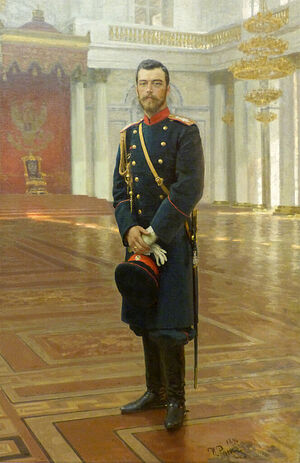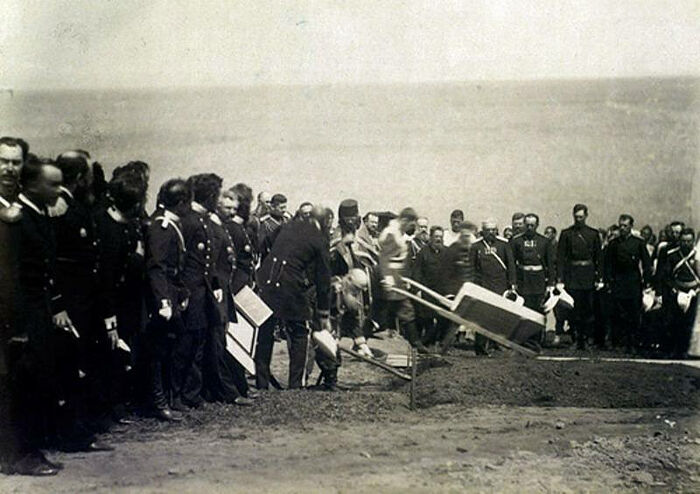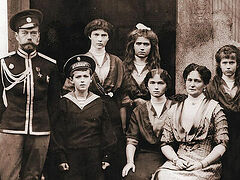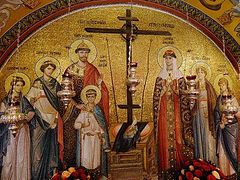On October 20 (November 2, according to the new style), 1894, Emperor Alexander III, the Peacemaker, reposed in Livadia. The next day, October 21 (November 3), Emperor Nicholas II ascended the All-Russian throne, and Empress Alexandra Feodorovna was joined to the Orthodox Church. On November 14 (27) of that same year, their wedding and coronation took place. Every week, the residents of Pskov, who have great reverence for the family of the last Russian Emperor, canonized as saints in 2000, pray to them in the Tsar’s chapel. In the Akathist to Tsar Nicholas II are words: “Rejoice, O peacemaker in your life.” Unfortunately, not many know about Nicholas II as a peacemaker. This highly relevant topic is addressed in the book, The Peacekeeping Activities of Emperor Nicholas II (1894–1917) by Viktor Nemerovsky, a candidate of pedagogical sciences, associate professor at Pskov State University; author of sixteen textbooks, eight monographs on education, history, and sports, five on health and educational technologies; he is also a recipient of the “Veteran” distinction from the Ministry of Science and Higher Education of the Russian Federation.
 Portrait of Emperor Nicholas II. 1896. Artist: Ilya Repin —Viktor Mikhailovich, in his sermon on July 4/17, St. John of Shanghai, Wonderworker of Western Europe and San Francisco, said that Tsar Nicholas II embodied the best traits of the Tsars of the House of Romanov; that the crime against him was all the more terrible and sinful because his entire family—including innocent children—was killed along with him, and that such crimes do not go unpunished. They cry out to Heaven and bring down God’s wrath on earth.
Portrait of Emperor Nicholas II. 1896. Artist: Ilya Repin —Viktor Mikhailovich, in his sermon on July 4/17, St. John of Shanghai, Wonderworker of Western Europe and San Francisco, said that Tsar Nicholas II embodied the best traits of the Tsars of the House of Romanov; that the crime against him was all the more terrible and sinful because his entire family—including innocent children—was killed along with him, and that such crimes do not go unpunished. They cry out to Heaven and bring down God’s wrath on earth.
—St. John (Maximovich) named the reason for what is happening to us now. It’s a pity that not everyone realizes that it is precisely for the murder of the defenseless Tsar-Martyr and his family that the entire Russian people, who allowed this terrible crime and remained silent when the Tsar was humiliated and deprived of freedom, now suffer. Bishop John said that Russia must bow before the humiliated, slandered, and martyred Tsar, that God’s Truth demands from us a deep understanding of the sinfulness of what was done and repentance before the memory of the Tsar, that this terrible crime committed against Tsar-Martyr Nicholas II and his much-suffering family should be atoned for by fervent veneration of him and glorification of his feat.
Born on the day of the memory of righteous Job the Much-Suffering, the most pious and much-suffering Tsar Nicholas showed patience in times of severe trials, similar to Job’s patience. Long before the glorification of Nicholas II and his family, Archbisho[ John called on everyone to pray to them, as did the great Elder Nikolai Guryanov, who called the Russian people’s veneration of the Royal Martyrs, “Russia’s spiritual shield.” And today, when some of our contemporaries continue to ask the question: “So who is Nicholas II—St. Nicholas, or Bloody Nicholas?” we should not doubt his sanctity. The last Russian Emperor forgave his murderers and asked not to take revenge for him and his family, but to remember that, although evil in the world will multiply, it is not evil that will prevail, but only love. The Gospel says: By their fruits you shall know them (Matt. 7:20). And the Beatitudes remind us: Blessed are the peacemakers, for they shall be called sons of God (Matt. 5:9). Unfortunately, not many know about Nicholas II as a peacemaker.
—Viktor Mikhailovich, your book contains many unknown facts, as well as prophecies about the fate of Russia and the role of its last Emperor. You also quote St. John of Shanghai.
—According to Bishop John, Nicholas II was most similar to Tsar Alexei Mikhailovich the “Most Peaceful”, but undoubtedly surpassed him in meekness. Nicholas II’s reforms were implemented more wisely and without the abruptness characteristic of Peter the Great. Russia admires Alexander I the Blessed, who liberated Europe from Napoleon. But under more difficult conditions, Emperor Nicholas Alexandrovich stood up against the tyranny of the Triple Alliance, and it is not his fault that Russia did not reach a victorious end. Following after Alexander II the Liberator, Tsar Nicholas II liberated even more people, not only Slavic but more than ten other nationalities. Following in the footsteps of his father, Alexander III the Peacemaker, Tsar Nicholas II initiated and implemented the most humane Peace project, which will remain relevant as long as humanity lives. His entire life was a service to God and the people. S. Yu. Witte, P. A. Stolypin, V. N. Kokovtsov, and other prominent statesmen of the late nineteenth and early twentieth centuries testified that Nicholas II simultaneously initiated, supervised, and financed more than 30 international-level peacekeeping projects. He not only initiated but also brought to life such century-defining projects as the Trans-Siberian Railway, the UN, and the construction of the subway [in major Russian cities]. Now enjoying their fruits, we do not even think about whom we should thank for them. And we should thank Nicholas II, who for twenty-two years was engaged in Russia’s internal and foreign policy projects, eighteen years in educational and healthcare reforms, seventeen years in Peace Conferences, and sixteen years in military reform. The successes of Emperor Nicholas II’s reign cannot fail to impress even skeptics.
Both Witte’s successful monetary reform and Stolypin’s agrarian reform (the emancipation of peasants from being bound to gentry-owned land) authors proposed naming the “Nikolaevsky” reforms, because it was Nicholas II who initiated and supervised them. All his reforms aimed at a peaceful and prosperous life for Russia’s subjects and allies. Under his reign, there was a clear improvement in the well-being of the people. Free medical care for the poor had been in place since 1898. In 1906, the best labor legislation in Europe and free compulsory primary education were established. And after all he did for the prosperity of Russia, the Tsar and his family were murdered by criminals.
—Everything you listed completely refutes the century-old myths of “bloodthirstiness,” “weak-will,” and “incompetence” of the last Emperor of Russia. The trials he and his family endured purified those innocent sufferers like gold in the furnace. But the myths about Nicholas II and his family, canonized as saints, continue to live even today.
—These myths are devastatingly debunked by a series of documentaries with characteristic titles by the well-known historian Alexander Bokhanov (“Ahead of His Time”), Pyotr Multatuli (“Thwarted Triumph”), and television journalist Elena Kozenkova (“Economic Miracle”). Elena Kozenkova wrote in an article about Alexander Bokhanov, whom the Tsar himself brought to God, about the need for a historical restoration of the slandered image of Tsar Nicholas, how the intensified slander from the Soviet period must be diligently and patiently exposed.
Thoughtful journalists, writers, and analytical economists like I.L. Solonevich and V.M. Lavrov, following historians of Nicholas II’s reign (N.N. Obruchev, S.S. Oldenburg, N.D. Talberg, and others), rightly believe that this period was characterized by an unprecedented flourishing of science, industry, and agriculture. This period (especially 1907–1914) can be called an economic miracle, bringing Russia as close as possible to autarchy.
—What is autarchy?
—This word (from the Greek αὐτός “self” and κράτος “power”) means a system of closed reproduction of a community with minimal dependence on exchange with the external environment. In other words, it is an economic regime of self-sufficiency, complete economic independence, and a state’s self-reliance or the maximal striving for them.
—Now, sanctions are pushing Russia towards autarchy. But do we have any chances of seeing its fruits?
—Only God knows. If not for the betrayal of Emperor Nicholas II, whose reign lasted twenty-two years, four months, and three days, he could very well have seen the fruits of autarchy with his own eyes, as he strived all his life to fulfill the covenants of his father, Emperor Alexander III: to seek peace with all states in foreign policy and to strive for the peaceful prosperity of the peoples of Russia in domestic policy.
Unfortunately, during Nicholas II’s reign, the rampage of global evil in both domestic and foreign policy reached its peak. Convincing the entire civilized world that the Russian superpower would do everything to ensure that there were no wars on Earth, and understanding that at any moment the superpowers could unite into a single military bloc against Russia, the Tsar initiated and participated in two International Peace Conferences on disarmament in The Hague, in 1899 and 1907. For more than a hundred years, a huge portrait of Nicholas II, the first nominee for the Nobel Peace Prize, hangs in the grand hall of the Peace Palace in The Hague. He became this nominee in 1901. He is the only statesman of modern times who proclaimed Christian commandments as the basis of life both in Russia and worldwide.
—Not finding an opportunity to reconcile with the Triple Alliance, he concluded a military agreement with France and England (the Entente) to prevent a world war. When anti-monarchist sentiments were brewing in Russian domestic politics, the Tsar found a compromise for reconciliation with the opposition. The culmination was the Manifesto of October 17, 1905, proclaiming political and civil liberties. But the intensity of terrorism in Russia did not diminish. Despite the state of emergency introduced by P.A. Stolypin in 1906, which temporarily halted the revolutionary frenzy, revolutionaries killed about 12,000 representatives of the tsarist government from 1901 to 1907, leaving the Tsar with few to rely on.
—The most astonishing thing is that neither the political banditry of 1901–1907, the peak of the 1905–1907 revolution, the onset of the world war, nor more than ten assassination attempts on the Tsar and his family could force him to change his peacekeeping course in the country’s domestic and foreign policy! When slandered, betrayed by everyone, and unlawfully dethroned, the Anointed of God and his Royal family received invitations to leave for England, Germany, or Scandinavia, they responded that they wished to share the fate with their people. The entire life of the Tsar’s family was pious and aimed at active peacekeeping.
In my book, I present far from a complete list of the most effective projects and reforms realized during the reign of the last Russian Emperor. I provide a chronology of peacekeeping projects aimed at saving states and their peoples from colonization or physical extermination and the years of their implementation. This includes the rescue of China, Korea, Japan, Tibet, France, Italy, Siam (Thailand), the Balkan countries, and Turkish Armenia. This also includes the autonomy of Mongolia, the rescue of Turkey from partition, and much more.
—It is known that the Tsar had projects for the future development of Russia, which he did not manage to realize due to the onset of World War I and his subsequent forced removal from power.
—The copyright for the tsarist projects was later appropriated by Lenin and Stalin. Nicholas II did not manage to realize the Third International Peace Conference, the electrification of Russia (GOELRO), the construction of hydroelectric power plants, the Baikal-Amur Mainline (BAM), the White Sea Canal, and the metropolitan subway system. He did not have time to introduce universal secondary education, although he planned to work on these projects.
Using the longest railway in the world today—the Trans-Siberian Railway—do we thank the last Emperor of Russia for it? No. Yet, he dedicated more than 25 years of his life to his brainchild, starting work on this project while still Tsesarevich. We discussed this at a roundtable in Pskov within the framework of the traveling photo exhibition “The Eastern Journey of Tsesarevich Nicholas Alexandrovich. 1890–1891,” brought to Pskov by its organizers and participants of the automobile pilgrimage, “Holy Russia.”
 Tsesarevich carries the first wheelbarrow onto the roadbed
Tsesarevich carries the first wheelbarrow onto the roadbed
—During his nine-month Eastern journey, Nicholas Alexandrovich personally led the laying of the Ussuri section of the Great Siberian Railway in Vladivostok. But who knows about this?
—On April 17, 1891, Emperor Alexander III instructed the heir to the throne, upon returning to Russian soil after his journey to the East, to announce the start of construction at the state’s expense of a continuous railway through the Asian part of Russia, to connect the abundant gifts of Siberian nature with the internal rail network. Fulfilling his father’s will, the Tsesarevich headed the Siberian Railway Committee, which connected Siberia with other parts of the Empire, demonstrating the Tsar’s keen care for its peaceful prosperity. On May 19, 1891, after a prayer service, Nicholas Alexandrovich, like a simple worker, took a shovel, filled a wheelbarrow with earth, and carried it onto the roadbed of the future railway.
The Tsesarevich also personally laid the foundation stone for the railway station building at the “Vladivostok” station. Taking a hammer and trowel, he devoutly made the sign of the cross and cemented the commemorative plaque in the cornerstone.
The Trans-Siberian Railway, built under Nicholas II, holds colossal significance even today. Without it, there would be no “Russian economic miracle.” Through the Trans-Siberian Railway, the Emperor began brilliantly implementing the Great Asian Program, to which he devoted 15 years of his life. If Peter I “opened a window to Europe,” then Nicholas II “opened a window to Asia.”
The entire life of Emperor Nicholas II and his family was dedicated to serving God and the people. Their sacrificial service to Russia was a life lived according to the Gospel commandments. They not figuratively but literally laid down their lives for their friends. We must honor the great feat of this holy family and pray to them every day.




